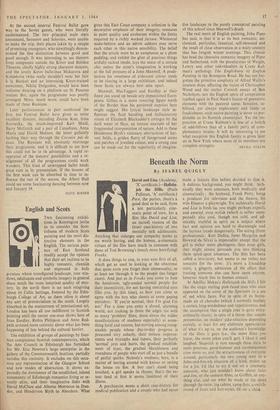English and Scots
Two faScinating exhibi- tions in Kensington invite us to consider the Scot- tishness of modern Scots painting and the most dis- tinctive elements in the English. The serious pain- ters of East Scotland readily accept the opinion that their art inclines to be highly romantic, clannish and expressed in belle peinture where transfigured landscape, rose win- dows, odalisques and symbolic imagery in general share much the same luxuriant quality of mys- tery. In the north there is no such misgiving about its Celtic heritage, fostered by the Edin- burgh College of Art, as there often is about any sort of provincialism in the south. Largely absorbed in the mainstream of international art, London has been all too indifferent to Scottish painting until the recent one-man shows here of Joan Eardley, Robin Philipson and Anne Red- path aroused more curiosity about what has been happening of late behind the cultural barrier.
The exhibition of groups of paintings by four- teen conspicuous Scottish contemporaries, which the Arts Council in Edinburgh has furnished for Mr. Eric Newton's large enterprise in the gallery of the Commonwealth Institute, partially satisfies this curiosity. It excludes on this occa- sion any representation of the Glasgow School and new modes of abstraction. It shows ex- pectedly the dominance of the established, inbred community of Edinburgh romantics living or re- cently alive, and their imaginative links with David McClure and Alberto Morrocco in Dun- dee, and Henderson Blyth in Aberdeen. What gives this East Coast company a cohesion is the decorative emphasis of their imagery, sensuous in paint quality and exuberant within the limits required by a richly worked facture. Whimsical make-believe and an adroit address may serve each other in this native sensibility. The belief that the article must be as sumptuous as a plum pudding, and exhibit the glint of precious things artfully tucked inside, lays the snare of a certain chic unless the artist's imagination is working at the full pressure of a John Maxwell. A predi- lection for sweetness of iridescent colour tends to be cloying in a large exhibition, and indeed these Scots are always best seen apart.
Maxwell, MacTaggart and Eardley at their finest can stand up beside any impassioned Euro- peans. Gillies .is a more towering figure north of the Border than his patterned caprices here might suggest. His lyrical landscape style in- fluences the fluid handling and hallucinatory vision of Elizabeth Blackadder's cottages by the dark water of Skye, an intense example of her fragmented interpretation of nature. Add to these Henderson Blyth's visionary abstractions of har- vest fields, a golden flurry of foreground stems and patches of jewelled colour, and a strong case can be made out for the superiority of imagina- tive landscape to the purely conceptual painting of this school since Maxwell's death.
The real merit of English painting, John Piper has said, is that it is at its best romantic, un- classical, particular, fanatical, self-obsessed and the result of close observation in a misty country that has longish winter evenings. This climate has bred the obsessive romantic imagery of Piper and Sutherland, with the peculiarities of Weight, Lowry and. other individualists in Crane Kal- man's anthology The Englishness of English Painting in the Brompton Road. He has not for- gotten the primitive simplicity of Alfred Wallis's timeless ships, affecting the vision of Christopher Wood and the earlier Cornish .essays of Ben Nicholson; nor the English spirit of compromise typified again in Paul Nash's fusion of geometric elements with the pastoral scene. Sensitive, in- hibited, yet always exploratory, and liable to freakishness, such native painting is never so pre- dictable as its Scottish counterpart. Yet the im- pression at Crane Kalman's is less of a bunch of odd-fellows than of a family party of com- plementary strains. It will be interesting to see what reception this English family is given later on in New York where most of its members are






























 Previous page
Previous page